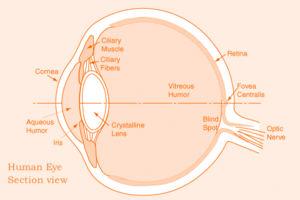Cataract facts for kids
A cataract is like a cloudy spot that forms in the clear lens of your eye. Imagine looking through a dirty window – that's a bit what it's like. This cloudiness can make it hard for light to pass through, making your vision blurry.
When cataracts first start, they might make you a bit more nearsighted. This means faraway things look blurry. Over time, the lens can also turn yellowish, which might make it harder to see blue colors clearly. Cataracts usually get worse slowly. If they are not treated, they can cause serious vision loss or even blindness. Most of the time, cataracts affect both eyes, but one eye usually gets cloudy before the other.
The word Cataract comes from the Latin word cataracta, which means "waterfall." It also comes from the Greek words kataraktes and katarrhaktes, meaning "to dash down." Some people think the name came about because it felt like an "obstruction" in front of the eye. Long ago, some doctors thought blindness was caused by bad fluid pouring into the eye, like a waterfall. In some parts of England, a cataract was even called a pearl, like "pearl eye."
Contents
History of Cataract Treatment
People have known about cataracts for a very long time! The first records of cataracts and their treatment can be found in ancient texts like the Bible and old Hindu writings.
One of the earliest known eye surgeons was an Indian surgeon named Sushruta, who lived around 600 BCE. He developed a way to treat cataracts. He used a special curved needle called the Jabamukhi Salaka. He would use this needle to gently move the cloudy lens out of the way so the person could see again. After the procedure, the eye would be treated with warm butter and bandaged. Sushruta said this method should only be used when it was really needed.
Greek doctors and thinkers traveled to India to learn about these surgeries. The idea of removing cataracts through surgery also traveled from India to China.
In Ancient Rome, the first mentions of cataracts and their treatment appeared around 29 CE. This was in a book called De Medicinae, written by Aulus Cornelius Celsus. The Romans were very good at health care, especially eye care.
A very important step in cataract surgery happened around 1000 CE. An Iraqi eye doctor named Ammar ibn Ali of Mosul was the first to remove cataracts using suction. He invented a hollow metal syringe (like a needle). He would use this needle to gently suck out the cataract. He wrote about his invention and how he discovered this technique while trying it out on a patient.
Signs and Symptoms
When a cataract gets cloudier, it becomes harder to see clearly. Your visual acuity (how sharp your vision is) gets worse. It also becomes harder to see differences in light and shadow, and colors might look less bright.
Sometimes, light can scatter because of the cataract, causing a bright glare. This can make it hard to see, especially at night around street lights. If you start to see a "halo" around lights at night, especially in just one eye, it's a good idea to talk to an eye doctor. They can do a contrast sensitivity test to see if your vision is affected.
What Causes Cataracts?
Cataracts can develop for many reasons. Here are some of the common ones:
- Aging: As people get older, their eye lenses can naturally become cloudy. This is the most common cause.
- Sunlight: Spending a lot of time in the sun without ultraviolet-protecting sunglasses can increase the risk.
- Radiation: Being exposed to certain types of radiation can cause cataracts. For example, studies have shown that commercial airline pilots are more likely to get cataracts. This might be because they are exposed to more radiation from outer space when flying high up. People who work with hot materials, like glassblowers, can also get cataracts from infrared radiation.
- Health Conditions: Diseases like diabetes and high blood pressure can increase the risk of cataracts.
- Injuries: A serious eye injury or other physical trauma to the eye can cause a cataract to form, sometimes many years later.
- Genetics: Sometimes, cataracts can run in families. Some babies are even born with cataracts, which are called congenital cataracts.
Cataracts happen when the proteins in the eye's lens change and clump together, making the lens cloudy.
Preventing Cataracts
While there's no guaranteed way to prevent cataracts, some things might help slow them down:
- Wear Sunglasses: Protecting your eyes from the sun's ultraviolet rays by wearing sunglasses can be helpful.
- Eat Healthy: Eating foods rich in antioxidants (like vitamins A, C, and E) is good for your overall health, including your eyes. However, taking these as supplements hasn't been proven to prevent cataracts.
- New Treatments: Scientists are always looking for new ways to treat and prevent cataracts. Some eye drops containing a substance called N-acetylcarnosine are being studied. These drops are thought to help by reducing damage to the lens. They might be especially useful for older people or those who cannot have surgery.
Images for kids
See also
 In Spanish: Catarata para niños
In Spanish: Catarata para niños







